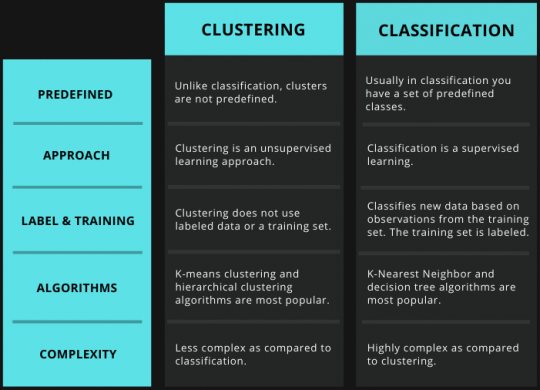More and more organizations have enormous amounts of data that are valuable resources for customer segmentation, sales management, and targeted marketing.
However, until these datasets can be sufficiently analyzed and evaluated, they are of no value to a company. The information is abundant, but only those who know how to use it can benefit from it.
Data mining techniques are used in many areas of research, including mathematics, cybernetics, genetics, and marketing. They are a means of predicting customer behavior.
Each type of data mining application is supported by a set of algorithmic approaches that are used to extract the relevant relationships in the data.
These approaches differ depending on the type of problem you are trying to solve.
After reading this article, you’ll come to know the difference between the two most prominent approaches i.e. clustering and classification.
Data Mining Clustering vs. Classification
Clustering is a method of machine learning that involves grouping data points by similarity.
The two common clustering algorithms in data mining are K-means clustering and hierarchical clustering.
It is an unsupervised learning method and a popular technique for statistical data analysis.
For a given set of points, you can use classification algorithms to classify these individual data points into specific groups.
As a result, data points in a particular group exhibit similar properties. At the same time, the data points of different groups have different characteristics.
The clustering algorithm and appropriate parameter settings depend on the individual datasets. It is not an automatic task, but an iterative discovery process.
Therefore, it is necessary to modify the data processing and the modeling of the parameters until the result reaches the desired properties.
Clustering techniques look for similarities and differences in a data set and groups similar records into segments or clusters, automatically, according to some criterion or metric.
Unlike classification, clusters are not predefined and can take different forms depending on the data analyzed.
Classification is a categorization method that practices a set of training data to distinguish, differentiate, and recognize objects.
It is a supervised learning method in which a set of training & well-defined observations are available.
Usually, in the classification you have a set of predefined classes. It assigns individual data objects to certain predefined classes that were previously not assigned to these classes.
The algorithm that performs the classification is the classifier while the observations are the instances.
Classification looks for new patterns, even if it means changing the way the data is organized.
The most popular classification algorithms in data mining are the K-Nearest Neighbor and decision tree algorithms.
Classification is a predictive modeling approach for predicting the value of certain and constant target variables.
Fabricating on the database, the model will build sets of binary rules to divide and classify the highest proportion of similar target variables.
Also Discover: Pros and Cons of Data Mining Explained
Classification is a supervised learning whereas clustering is an unsupervised learning approach.
Clustering groups similar instances on the basis of characteristics while the classification specifies predefined labels to instances on the basis of characteristics.
Clustering divides the dataset into subsets to group together instances with similar functionality. It does not use labeled data or a training set.
On the contrary, classification classifies new data based on observations from the training set. The training set is labeled.

Concluding Words
Although you can practice each method separately, it is considered common to use both when conducting an analysis.
Each method has unique benefits and blends to increase the robustness, durability, and overall utility of data mining models.
Supervised models can take benefit of the nesting of variables determined from unsupervised methods.
You May Also Like To Read:
Collibra vs. Alation: Comparison of the Two
What is Cluster Computing and how it is different from Cloud Computing?




